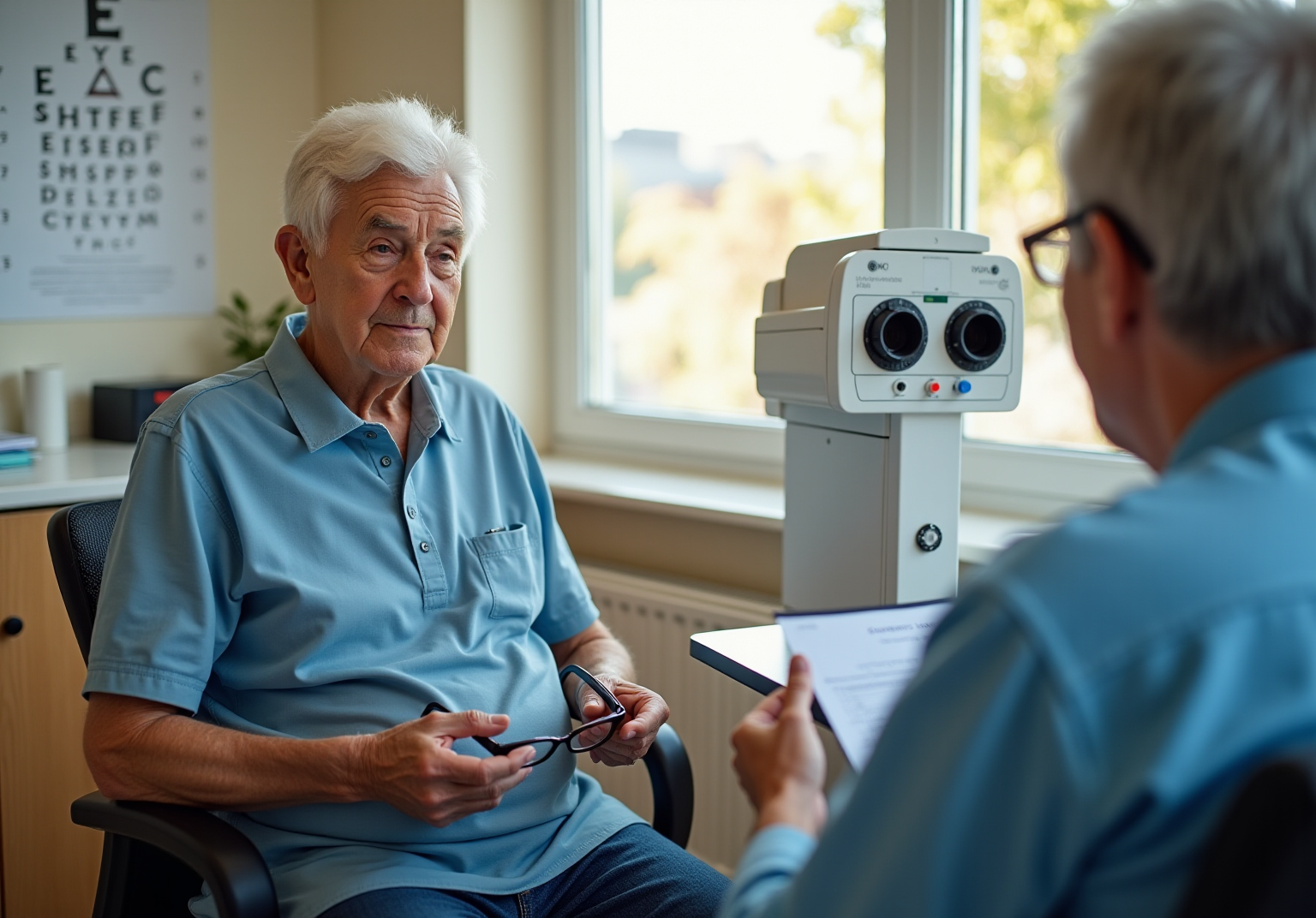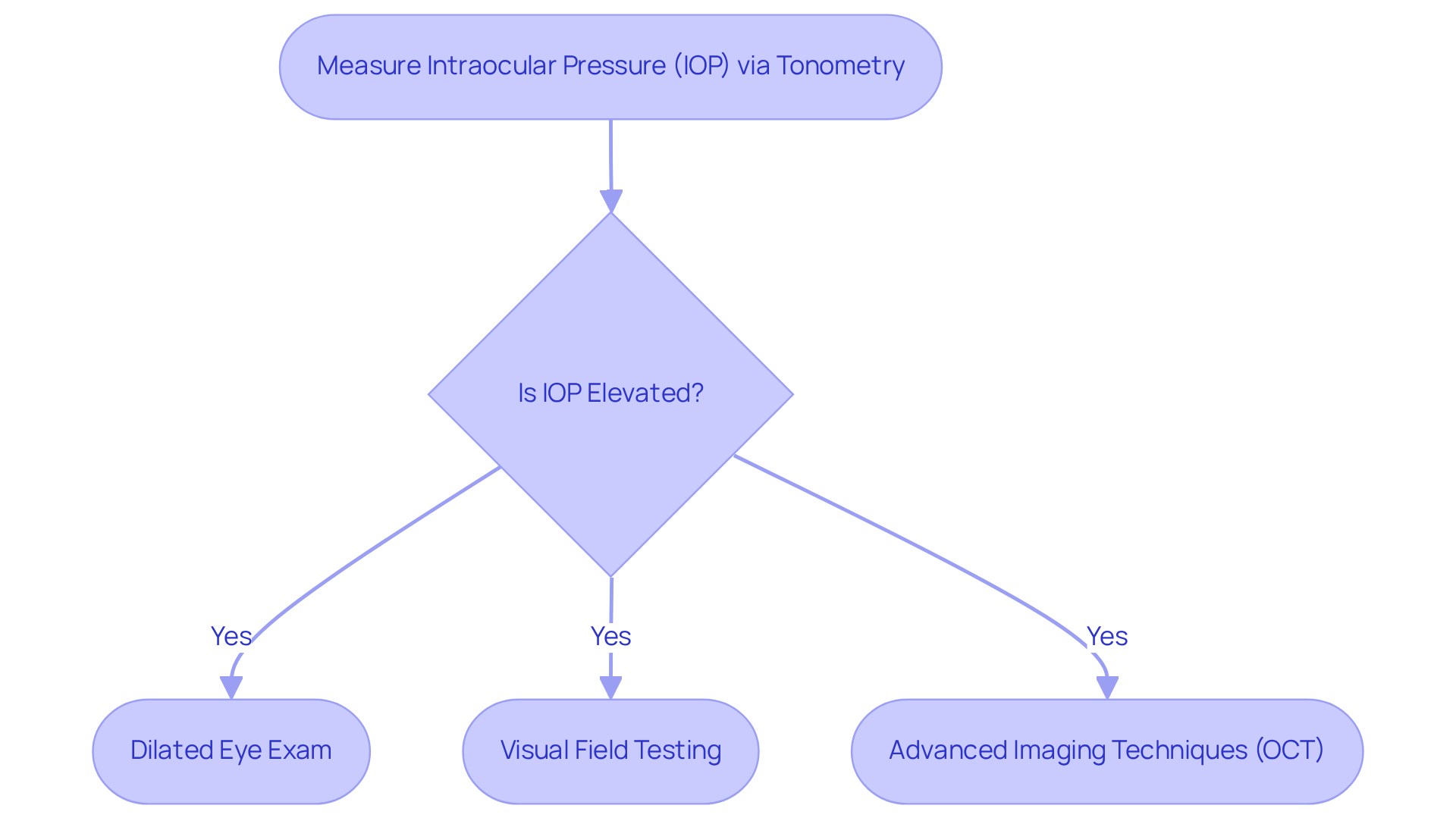


Understanding the nuances between ocular hypertension and glaucoma is vital, especially for seniors who may feel anxious about their eye health. While ocular hypertension might not show immediate symptoms, it can indicate potential threats to vision, leading to serious complications if not addressed.
Have you ever wondered what steps you can take to protect your eyesight and distinguish between these two often-confused conditions? This article explores the critical differences, symptoms, and management options, empowering you to take proactive steps in your eye care journey.
Remember, you’re not alone in this - support is available to help you navigate these concerns.
Ocular hypertension is a condition characterized by intraocular pressure (IOP) higher than normal, typically above 21 mm Hg, especially when considering ocular hypertension vs glaucoma. It’s important to note that this occurs without any detectable damage to the optic nerve or loss of vision. However, this condition can be a precursor to more serious eye diseases, particularly in the context of ocular hypertension vs glaucoma, which cause progressive damage to the optic nerve and are often linked with elevated IOP. If left untreated, these diseases can lead to vision loss.
For seniors, understanding these definitions is crucial. They are at a higher risk for both ocular hypertension and related eye conditions. Early intervention can make a significant difference in maintaining their quality of life. Have you or a loved one experienced any changes in vision? It’s always best to consult with a healthcare professional if you have concerns.
Remember, while discussing ocular hypertension vs glaucoma, it’s important to note that ocular hypertension doesn’t always lead to serious eye conditions, but being proactive about eye health is essential. Seeking help early can provide peace of mind and potentially protect your vision. Your health matters, and there are resources available to support you.

Ocular hypertension vs glaucoma is often overlooked, as ocular hypertension typically presents with no symptoms. This makes regular eye exams essential for detection. However, as we compare ocular hypertension vs glaucoma, this condition can progress and exhibit various symptoms that are important to recognize.
Elderly individuals may experience blurred vision, halos around lights, intense eye pain, headaches, and nausea. These signs indicate issues related to ocular hypertension vs glaucoma, requiring urgent medical attention. Unfortunately, many seniors may not recognize or report these symptoms until significant damage has occurred. This highlights the critical need for proactive eye care.
Did you know that older adults are six times more likely to develop ocular hypertension after age 60? It’s one of the primary causes of blindness for individuals beyond this age. This highlights the importance of awareness and regular screenings for ocular hypertension vs glaucoma, beginning at age 40. Furthermore, Medicare Part B covers eye tests annually for African Americans aged 50 and older and Hispanic Americans aged 65 and older, making these screenings more accessible.
Eye care experts emphasize that early identification of conditions such as ocular hypertension vs glaucoma through regular check-ups can prevent permanent vision impairment. It’s essential for older adults and their caregivers to prioritize eye health. Additionally, this condition tends to run in families, which is an important consideration for proactive testing.
Routine assessments are straightforward and comfortable. They involve pressure tests and pupil dilation to inspect the optic nerve, easing concerns and motivating older adults to pursue these examinations. Significantly, only half of individuals affected by this condition are aware they have it. This highlights the necessity for education and awareness among seniors.
Let’s take care of our eyes together. Regular check-ups can make a world of difference!

Diagnosing ocular hypertension starts with a simple yet crucial step: measuring intraocular pressure (IOP) through tonometry during a comprehensive eye exam. If your eye doctor detects increased IOP, don’t worry - further assessments like visual field tests and optic nerve imaging will be performed to ensure your eye health is thoroughly evaluated, especially regarding ocular hypertension vs glaucoma.
In addition to this, diagnosing the condition of ocular hypertension vs glaucoma requires a more detailed approach. This includes:
These methods are particularly vital for seniors, as early detection can significantly reduce the risk of irreversible vision loss, especially when considering ocular hypertension vs glaucoma.
Furthermore, recent advancements in eye pressure diagnostics have greatly enhanced precision. Tonometry has shown a high reliability rate in identifying elevated IOP, which is reassuring for both patients and eye specialists. Regular screenings are highly recommended, especially for those at higher risk, to ensure timely intervention and optimal eye health management. Remember, taking these steps can make a world of difference in preserving your vision.

Managing ocular hypertension vs glaucoma is crucial for maintaining your vision, and it typically involves regular eye exams and, when needed, prescription eye drops to help lower intraocular pressure (IOP). This proactive approach is essential to prevent any progression towards vision loss. But managing eye pressure can require a more comprehensive strategy. Often, this includes:
For elderly patients, creating a personalized care plan is vital. This plan should consider your overall health and any existing conditions, ensuring the best possible outcomes. Recent advancements in managing eye pressure conditions have shown promising success rates among older adults. For example, studies reveal that nearly three-quarters of patients treated with selective laser trabeculoplasty (SLT) remain medication-free six years after treatment, significantly lowering the risk of peripheral vision loss.
Real-life examples highlight the effectiveness of tailored care plans. One elderly patient with ocular hypertension managed their condition successfully through a combination of lifestyle changes and prescribed eye drops, avoiding the progression to more severe eye disease. Such personalized approaches not only enhance comfort but also improve adherence to care plans, leading to better health outcomes.
As research continues to evolve, exciting advancements in eye care for seniors are emerging. Innovative drug delivery systems, like the FDA-approved iDose® TR implant, provide continuous medication therapy for up to three years, while minimally invasive surgical options are also becoming available. These advancements promise to improve medication adherence and effectiveness. Furthermore, global collaboration among researchers and healthcare professionals is significantly advancing our understanding of eye conditions, leading to more efficient solutions and potential remedies. As Derek Welsbie, MD, PhD, noted, "With every discovery and technological advancement, we progress nearer to attaining more effective therapies and, ultimately, a remedy for this eye condition." These developments represent a significant step forward in understanding ocular hypertension vs glaucoma, offering hope for a better quality of life among elderly patients.

Understanding the differences between ocular hypertension and glaucoma is crucial, especially for seniors who may be at a higher risk for these conditions. Ocular hypertension, which involves elevated intraocular pressure without any damage to the optic nerve, can be a warning sign for more serious issues like glaucoma. This condition leads to progressive optic nerve damage and can result in vision loss. By recognizing these distinctions, individuals can take proactive steps to protect their eye health.
Regular eye exams are essential, as ocular hypertension often shows no symptoms, making early detection vital. Seniors, in particular, face a significant increase in risk after age 60. It's important to be aware of symptoms such as blurred vision and intense eye pain, as these can signal the need for timely medical intervention. Additionally, diagnostic methods and treatment strategies have advanced, focusing on personalized care plans that cater to individual health needs and incorporate innovative developments in eye care.
Ultimately, prioritizing eye health through awareness, education, and regular check-ups can greatly enhance the quality of life for seniors. By staying informed and seeking timely care, individuals can reduce the risks associated with ocular hypertension and glaucoma, ensuring a brighter future for their vision. Taking action today can lead to a more secure tomorrow, reinforcing the idea that proactive eye care is not just beneficial but essential.
Have you scheduled your next eye exam? Remember, your vision matters, and taking these steps can make all the difference.
What is ocular hypertension?
Ocular hypertension is a condition characterized by intraocular pressure (IOP) higher than normal, typically above 21 mm Hg, without any detectable damage to the optic nerve or loss of vision.
How does ocular hypertension differ from glaucoma?
Ocular hypertension occurs without detectable optic nerve damage or vision loss, while glaucoma is a group of diseases that cause progressive damage to the optic nerve and are often associated with elevated IOP.
What are the potential risks associated with ocular hypertension?
Ocular hypertension can be a precursor to more serious eye diseases, particularly glaucoma, which can lead to vision loss if left untreated.
Why is it important for seniors to understand ocular hypertension and glaucoma?
Seniors are at a higher risk for both ocular hypertension and related eye conditions, and early intervention can significantly impact their quality of life.
What should individuals do if they experience changes in vision?
It is advisable to consult with a healthcare professional if you or a loved one experiences any changes in vision.
Can ocular hypertension lead to serious eye conditions?
While ocular hypertension does not always lead to serious eye conditions, being proactive about eye health is essential to prevent potential issues.
What resources are available for individuals concerned about their eye health?
There are various resources available to support individuals in maintaining eye health and addressing concerns about ocular hypertension and glaucoma.